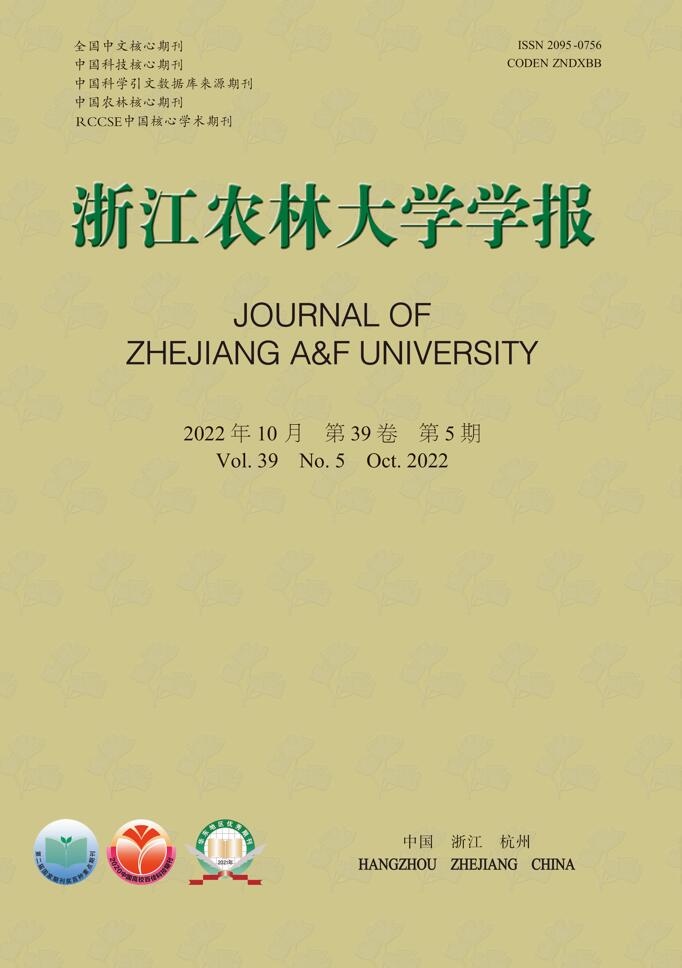-
随着中国经济的快速发展,花卉的需求量逐年增加,进而对作为花卉栽培基质的泥炭需求也日益迫切[1-2]。泥炭为不可再生资源,具有涵养水源、调蓄洪峰、调节气候、减少污染等生态功能,过度开采势必会造成湿地生态系统的破坏,加剧地球温室效应[3]。因此,寻找和发掘一种性能稳定、价格低廉的泥炭代替基质尤为重要[4]。已有研究表明:园林绿化废弃物堆肥质地疏松、养分全面,具有较强的保水保肥能力,可以替代泥炭用作栽培基质[5]。郝丹等[6]采用10%蛭石、10%珍珠岩和80%(体积比)园林绿化废弃物堆肥混合物作为金盏菊Calendula officinalis栽培基质,可有效提高金盏菊品质;倪肖卫等[7]将园林绿化废弃物堆肥作为基质进行佛甲草Sedum lineare栽培,其中园林绿化废弃物堆肥、蛭石和砂土体积比为6∶4∶1时,混合基质对佛甲草生长促进作用最显著。李燕等[8]研究发现:在泥炭中添加60%~80%的园林绿化废弃物堆肥,可以显著提高红掌Anthurium andraeanum和鸟巢蕨Asplenium nidus的生物量,表明园林绿化废弃物堆肥可以部分替代泥炭作为红掌和鸟巢蕨栽培基质。
波斯菊Cosmos bipinnata为菊科Compositae植物,因其色彩鲜艳,常被用于园林绿化[9]。目前将园林绿化废弃物堆肥用于波斯菊栽培的研究还未有报道。本研究将园林绿化废弃物堆肥替代或部分替代泥炭用作波斯菊栽培基质,并测定与分析栽培基质的理化性质和波斯菊生长状况,探究园林绿化废弃物堆肥用作波斯菊栽培基质的可行性,以期筛选出栽培基质的最佳配比,使园林绿化废弃物得到科学、经济、有效的利用。
-
波斯菊种子与供试泥炭(丹麦品氏泥炭)购于北京林大林业科技股份有限公司。供试园林绿化废弃物堆肥材料来源于北京市植物园堆肥厂。制作过程:堆肥前,将园林绿化废弃物、青储饲料和脱硫石膏按照体积比为40∶18∶1进行混合,添加尿素,调节堆肥混合物碳氮比(C/N)至25~30,浇水并维持含水量为60%~70%,再添加5 mL·kg−1微生物菌剂(康氏木霉Trichoderma koningii和黄孢原毛平革菌Phanerochaete chrysosporium混合物),最后将堆肥混合物堆成底面积1 m2、高1 m的堆体。在堆肥全过程中,隔3 d翻堆并补充水分。堆肥至28 d时测定相关指标表明,堆体已完全腐熟。
-
本研究于2021年6—10月在北京林大林业科技股份有限公司温室苗圃进行。共设置5个处理,每个处理设置5次重复。试验方案见表1。
基质代号
(处理)不同基质配比(体积比) 园林绿化废弃物堆肥/% 泥炭/% T100 100 0 T75 75 25 T50 50 50 T25 25 75 T0 0 100 Table 1. Experimental design
-
5个处理的混合栽培基质分别加入质量分数为0.1%的多菌灵杀菌消毒,混合均匀后将其分别装入180 mm×160 mm 的塑料花盆中,用于波斯菊栽培,同时采集栽培基质样品。
-
选取颗粒饱满的波斯菊种子用装满泥炭的育苗盘统一育苗,每穴1粒种子。育苗20 d后,在育苗盘中选取长势一致的波斯菊幼苗分别移栽到装有5种不同栽培基质的塑料花盆中,每盆1株。栽培期间1周浇水1次,以保证植物生长所需水分,其他管理措施保持一致[6]。栽培100 d后,测定每株波斯菊的花朵数和株高。测定后,将波斯菊整株挖出并用清水清洗干净,测定其鲜质量和根长。
-
栽培基质的容重、最大含水量、总孔隙度和通气孔隙等4个物理性质指标参考殷泽欣等[10]的方法测定。栽培基质的pH、电导率(EC)、全氮、全磷、全钾、速效磷和速效钾等7个化学性质指标参考鲍士旦[11]的方法测定。其中,称取一定量的风干样品并加入无水二氧化碳,风干样品与水的体积比为1∶10,在剧烈震荡10 min并过滤后,测定滤液pH和EC;样品在加入浓硫酸和过氧化氢消煮后分别测定全氮、全磷和全钾,其中采用凯氏定氮法测定全氮,采用752紫外光栅分光光度计测定全磷,采用FP640火焰光度计测定全钾;有效磷通过碳酸氢钠提取,钼锑抗比色法测定;速效钾经乙酸铵提取,火焰光度计测定。
-
分别用精度为0.01 g的电子秤称量洗净和烘干后的波斯菊地上部分质量和地下部分质量。用0~100 cm软尺测量花盆内基质表面至波斯菊成株最高点的距离作为株高;测定波斯菊根部最长根的长度作为根长;记录每株波斯菊花朵数[6]。
-
采用Office 2016软件进行数据处理,采用SPSS 6.1统计分析软件进行单因素方差分析(one-way ANOVA)和多重比较(P<0.05)。
-
由表2可知:随着园林绿化废弃物堆肥所占添加比例增加,不同栽培基质容重逐渐升高。其中,T100处理容重最大,与其他处理差异显著(P<0.05);T0处理容重最小,与其他处理差异显著(P<0.05)。ABAD等[12]指出:栽培基质的理想容重为<0.40 g·cm−3,且接近0.40 g·cm−3时更优。因此,除T100处理外,其他处理的栽培基质容重均处于理想范围内。其中,T75处理容重更接近理想值。
处理 容重/(g·cm−3) 最大含水量/% 总孔隙度/% 通气孔隙/% 处理 容重/(g·cm−3) 最大含水量/% 总孔隙度/% 通气孔隙/% T100 0.41±0.03 a 82.67±0.17 a 84.11±0.31 a 23.16±0.16 a T25 0.33±0.02 d 84.33±0.27 b 87.51±0.29 bc 17.88±0.11 c T75 0.39±0.02 b 83.06±0.21 ab 85.32±0.25 ab 20.55±0.24 b T0 0.31±0.03 e 85.95±0.23 b 88.93±0.28 c 15.40± 0.17 d T50 0.37±0.05 c 83.41±0.20 b 86.78±0.21 b 19.79±0.19 b 理想值 <0.40[12] 70.00~85.00[13] 70.00~90.00[14] 15.00~30.00[14] 说明:平均值±标准差(n=5)。同列不同小写字母表示不同处理间差异显著(P<0.05) Table 2. Physical properties of different cultivation substrates
-
由表2可知:随着园林绿化废弃物堆肥所占比例增加,不同栽培基质最大含水量逐渐降低。其中,T0处理最大含水量最高,与T100处理差异显著(P<0.05);T100处理最大含水量最低,与T50、T25和T0处理差异显著(P<0.05)。除T0处理外,其他处理的最大含水量均处于理想基质范围内[13],能够调节基质通气透水性,为根系生长提供适宜的水气环境。
-
由表2可知:随着园林绿化废弃物堆肥所占比例增加,不同栽培基质总孔隙度逐渐降低。其中,T0处理总孔隙度最大,与T100、T75和T50处理差异显著(P<0.05);T100处理总孔隙最小,与T50、T25和T0处理差异显著(P<0.05),所有处理均符合理想基质的总孔隙度要求[14]。而随着园林绿化废弃物堆肥所占比例增加,不同栽培基质的通气孔隙逐渐升高。其中,T100处理总孔隙最大,与其他处理差异显著(P<0.05);T0处理的通气孔隙最小,与其他处理差异显著(P<0.05),所有处理均达到基质通气孔隙的理想范围[14]。
-
由表3可知:随着园林绿化废弃物堆肥所占比例增加,不同栽培基质pH逐渐升高。其中,T100处理的pH最大,与其他处理差异显著(P<0.05);T0处理的pH最小,与其他处理差异显著(P<0.05)。因此,T100和T75处理超出理想范围[15],其他处理的pH更符合植物对酸碱度的要求。
处理 pH EC/(mS·cm−1) 全氮/(g·kg−1) 全磷/(g·kg−1) 全钾/(g·kg−1) 速效磷/(mg·kg−1) 速效钾/(mg·kg−1) T100 6.64±0.04 a 3.51±0.01 a 35.6±0.7 a 10.9±0.6 a 13.2±0.1 a 143±2 a 8 873±67 a T75 6.51±0.06 b 2.47±0.10 b 29.1±1.2 b 8.6±0.2 b 9.8±0.7 b 131±2 b 6 967±54 b T50 6.42±0.09 c 1.67±0.05 c 22.3±0.6 c 6.1±0.4 c 7.2±0.2 c 117±2 c 5 053±56 c T25 6.37±0.03 d 0.89±0.02 d 15.6±0.8 d 3.4±0.1 d 4.1± 0.4 d 103±1 d 3 136±38 d T0 6.26±0.07 e 0.39±0.03 e 7.7±0.2 e 0.2±0.0 e 0.3±0.0 e 86±1 e 1 218±20 e 理想值 5.20~6.50[15] 0.75~3.49[16] 说明:平均值±标准差(n=5)。同列不同小写字母表示不同处理间差异显著(P<0.05) Table 3. Chemical properties of different cultivated substrates
-
由表3可知:随着园林绿化废弃物堆肥所占比例增加,不同栽培基质EC逐渐升高。其中,T100处理的EC最大,与其他处理差异显著(P<0.05);T0的EC最小,与其他处理差异显著(P<0.05)。因此,除T100和T0处理外,其他基质的EC均处于理想范围内[16]。
-
由表3可知:随着园林绿化废弃物堆肥所占比例增加,不同栽培基质全氮、全磷、全钾、速效磷和速效钾质量分数逐渐升高。其中,T100处理养分(全氮、全磷、全钾、速效磷和速效钾)质量分数最高,与其他处理差异显著(P<0.05);T0处理养分(全氮、全磷、全钾、速效磷和速效钾)质量分数最低,与其他处理差异显著(P<0.05)。
-
由表4可知:与T0处理相比,T100、T75、T50和T25处理波斯菊地上部鲜质量、干质量及地下部鲜质量、干质量均显著增加(P<0.05)。其中,T50处理波斯菊地上部鲜质量、干质量及地下部鲜质量、干质量最高,T0处理最低,说明T50处理对波斯菊生物量积累效果最优。与T0处理相比,T50处理地上部鲜质量、干质量及地下部鲜质量、干质量分别提高了390.4%、322.2%、145.6%和93.1%。
处理 地上部 地下部 处理 地上部 地下部 鲜质量/g 干质量/g 鲜质量/g 干质量/g 鲜质量/g 干质量/g 鲜质量/g 干质量/g T100 9.77±0.13 d 0.61±0.03 d 1.96±0.07 d 0.42±0.05 d T25 16.59±0.07 b 0.93±0.04 b 2.37±0.11 b 0.51±0.04 b T75 12.01±0.19 c 0.72±0.07 c 2.11±0.13 c 0.47±0.06 c T0 6.48±0.11 e 0.36±0.08 e 1.60±0.24 e 0.29±0.02 e T50 31.78±0.21 a 1.52±0.10 a 3.93±0.06 a 0.56±0.02 a 说明:平均值±标准差(n=5)。同列不同小写字母表示不同处理间差异显著(P<0.05) Table 4. Effects of different cultivation substrates on the biomass of C. bipinnata
-
由表5可知:与T0处理相比,T100、T75、T50和T25处理波斯菊株高、花朵数和根长均显著增加(P<0.05)。其中,T50处理波斯菊株高、花朵数和根长最优,T0处理最差,说明T50处理能够显著促进波斯菊生长和根系发育,提高波斯菊观赏价值。与T0处理相比,T50处理株高、花朵数和根长分别提高了137.43%、108.99%和95.69%。
处理 株高/cm 花朵数/朵 根长/cm 处理 株高/cm 花朵数/朵 根长/cm T100 69.40±8.77 d 4.00±1.00 c 15.70±1.26 d T25 117.89±9.93 b 6.00±1.00 b 24.44±2.21 b T75 84.34±8.41 c 5.33±0.67 b 19.55±1.03 c T0 60.46±7.64 e 3.67±0.67 c 13.45±1.17 e T50 143.55±10.12 a 7.67±0.67 a 26.32±1.78 a 说明:平均值±标准差(n=5)。同列不同小写字母表示不同处理间差异显著(P<0.05) Table 5. Effects of different cultivation substrates on growth Indexes of C. bipinnata
-
园林绿化废弃物堆肥结构疏松,具有丰富的大小孔隙,可以提高基质的通气孔隙,降低基质的最大含水量,从而更好地协调基质间空气的流通和水分的运移,提高植物根部呼吸,有利于根系微生物活动[17]。同时,与泥炭相比,园林绿化废弃物堆肥较为紧实,因此,园林绿化废弃物堆肥的添加有利于适当提高基质的容重,增强基质对植物的支撑作用[18]。但是,当园林绿化废弃物堆肥添加比例为100%,栽培基质的容重较大,导致基质的疏松度降低,从而限制了基质与外界的空气交换,不利于植物根系生长[19]。综合可知:园林绿化废弃物堆肥添加体积比以25%~75%为宜,此时栽培基质的容重、最大含水量、总孔隙度和通气孔隙均在理想范围内,可以为植物生长提供适宜的物理环境。
-
栽培基质的化学性质反映了基质的酸碱环境和提供养分的能力[16]。园林绿化废弃物堆肥中含有大量的钙、镁、钾等碱性元素和硝酸盐、磷酸盐等可溶性盐,导致园林绿化废弃物堆肥的pH和EC均高于泥炭[20]。因此,随着园林绿化废弃堆肥体积比的提高,基质的pH和EC也逐渐升高。当园林绿化废弃物堆肥与泥炭的体积比≥75%时,基质的pH超出理想范围,不利于植物生长和发育。究其主要原因是由于过高的pH会降低磷、铁、镁等养分的有效性,从而降低基质中有效养分含量。当园林绿化废弃物堆肥添加比例为100%时,还会导致基质EC过高,对植物生长产生抑制作用。这是因为过高的EC会导致基质中的渗透势高于植物根系细胞渗透势,从而造成植物吸收水分和营养物质困难[21]。同时,园林绿化废弃物堆肥中含有大量营养物质,可以为植物的生长提供全面且长效的养分来源[22],但是,养分质量分数越高并不代表栽培基质越好,只有结合波斯菊生长情况,才能确定园林绿化废弃物堆肥替代泥炭的最佳比例。
-
综合分析可知:园林绿化废弃物堆肥的添加能够显著促进波斯菊生物量积累和根系生长,增加单株花朵数,从而提高波斯菊观赏价值。
T75、T50和T25处理栽培基质疏松多孔,保水保肥性强,养分丰富,能够为波斯菊生长提供适宜的物理环境和充足的养分。但是,T75处理栽培基质pH高于理想范围,会抑制波斯菊根系对养分的吸收,不利于波斯菊地上部分和地下部分的构建[23]。因此,T75处理波斯菊株高、花朵数、根长和生物量低于T50和T25处理。同时,栽培基质中的养分质量分数随着园林绿化废弃物堆肥添加比例的增加而升高,因此,与T25处理相比,T50处理栽培基质养分质量分数较高,更能满足波斯菊生长需求,有利于波斯菊地上部和地下部生物量积累,从而获得较高观赏价值的波斯菊植株。
T100栽培基质含有丰富的营养元素,但存在pH和EC较高及容重较大的问题。过高的pH不仅会抑制植物根部对氯离子(Cl−)、钾离子(K+)和硝酸根离子(NO3 −)等无机离子的吸收,还会引起植物生理干旱,破坏植物组织,影响植物体内新陈代谢[23-24]。过高的EC会降低植物的吸水能力从而引起渗透胁迫,导致植物发生盐害[25]。较大的容重会降低栽培基质通气透水性,不利于植物根部呼吸。因此,T100处理波斯菊株高、花朵数、根长和生物量均显著低于T75、T50和T25处理。
T0栽培基质具有适宜的总孔隙和通气孔隙,能够为波斯菊根系生长提供良好的通气性,但存在容重较小和EC较低的问题。较小的容重会导致基质紧实度降低,不利于基质对植物根系的固定[12]。较低的EC会导致基质中有效养分质量分数下降,不利于波斯菊生物量的积累和花朵数的增加,降低波斯菊观赏价值[24]。此外,T0处理栽培基质养分质量分数显著低于其他处理,不利于波斯菊地上部分和地下部分生物量积累和生长[23]。因此,T0处理下波斯菊株高、花朵数、根长和生物量最低,均显著低于T100、T75、T50和T25处理。
-
在泥炭中添加适量园林绿化废弃物堆肥制成栽培基质,可以增加基质养分质量分数,提高基质容重、通气孔隙、pH和EC。但园林绿化废弃物堆肥与泥炭的体积比>75%会导致栽培基质容重、pH和EC超出最优基质范围,不利于波斯菊生长。园林绿化废弃物堆肥部分替代泥炭可以显著提高波斯菊株高、花朵数、根长和地上部分及地下部分生物量,其中,以园林绿化废弃物堆肥∶泥炭为50∶50 (体积比)组成的栽培基质理化性质最为适宜,且波斯菊生长最佳。
Replacing peat with garden waste compost in Cosmos bipinnata cultivation
doi: 10.11833/j.issn.2095-0756.20210829
- Received Date: 2021-12-28
- Accepted Date: 2022-07-06
- Rev Recd Date: 2022-06-24
- Available Online: 2022-07-25
- Publish Date: 2022-10-20
-
Key words:
- green waste compost /
- peat /
- Cosmos bipinnata /
- cultivation substrate
Abstract:
| Citation: | YIN Zexin, ZHANG Lu, BAI Yifan. Replacing peat with garden waste compost in Cosmos bipinnata cultivation[J]. Journal of Zhejiang A&F University, 2022, 39(5): 1045-1051. DOI: 10.11833/j.issn.2095-0756.20210829 |









 DownLoad:
DownLoad: